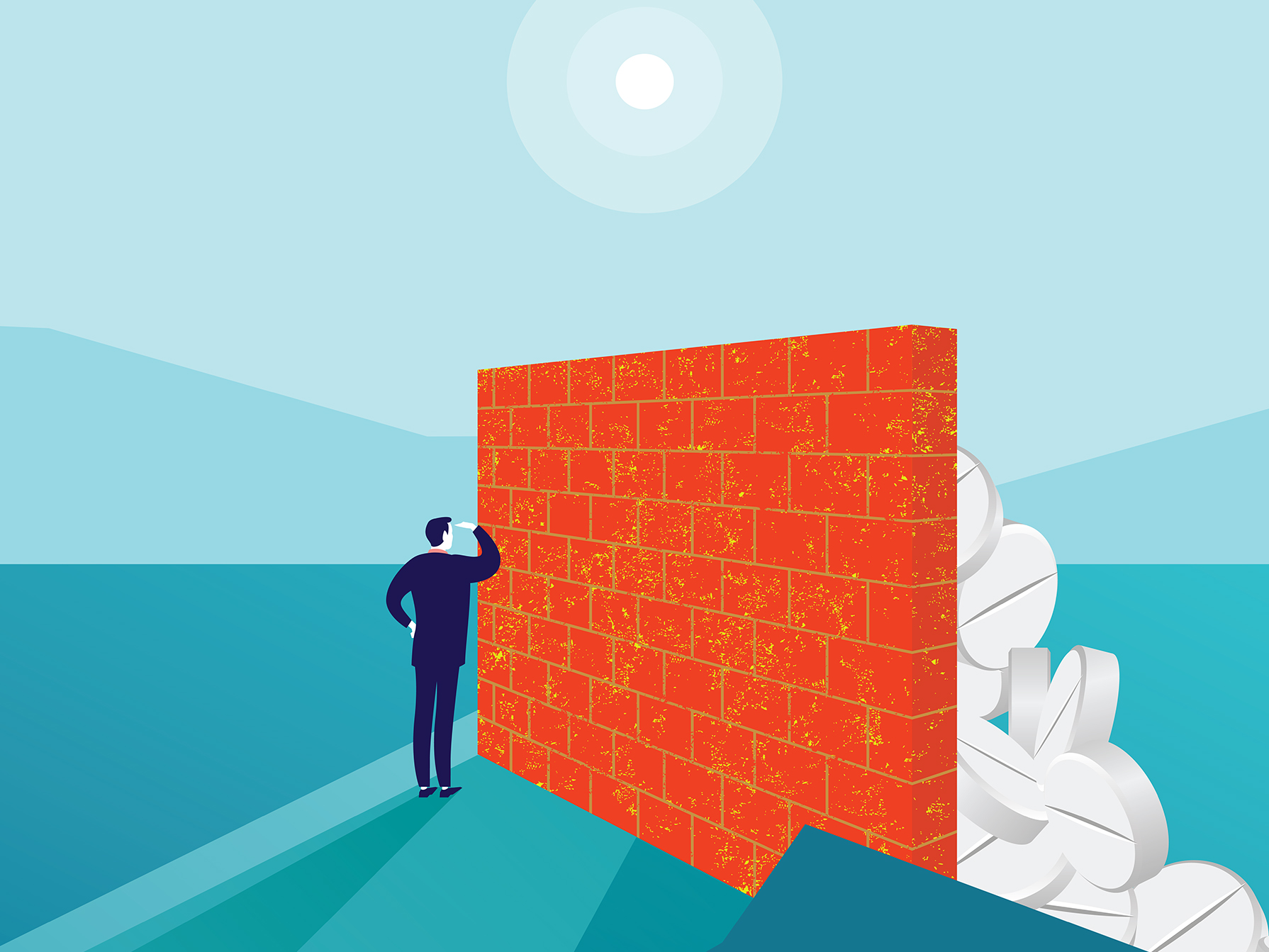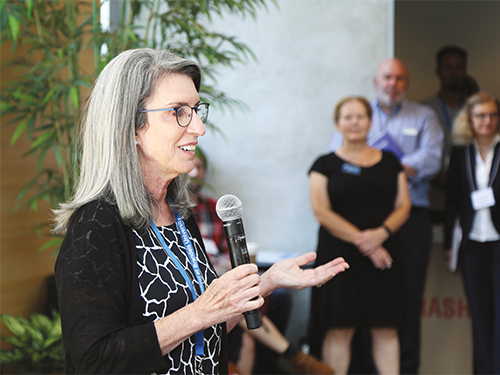
By Bethany Romano, MBA'17
As the deadliest drug addiction crisis in U.S. history, the opioid epidemic continues to generate shocking statistics and heartbreaking stories of addiction, overdose and loss.
Drug overdose deaths are now the leading cause of unintentional death in the U.S., and opioids; prescription painkillers, synthetic fentanyl and heroin; account for the vast majority of those deaths. Nearly 50,000 people died from opioid overdoses in 2017 alone, a fourfold increase from 2002.
Millions of people in the U.S. are estimated to have opioid use disorder (OUD), yet only 10 percent receive treatment, and fewer still have access to medication treatments like buprenorphine or methadone, now considered the gold standard in treating opioid addiction.
Cindy Parks Thomas, PhD’00, is arguing vociferously for a system-wide change to make medication treatments a mainstream option for opioid addiction. Thomas, who is associate dean for research and an affiliated researcher at the Opioid Policy Research Collaborative at Heller's Institute for Behavioral Health, penned a commentary in the Journal of Addiction Medicine in which she outlines her vision for a treatment system that improves patient access and better supports the health care workforce needed to prescribe these medications.
(This interview has been edited for length and clarity.)
BETHANY ROMANO: Let's start with the current treatment landscape. For the 2.5 million people in the U.S. who are addicted to opioids, what medications are available to treat their addiction?
CINDY PARKS THOMAS: When most people think of medication treatments for drug addiction, they think of methadone, which has been around for many years. Methadone has to be dispensed to the patient in person every day at a specialized clinic.
The new medications that are available to treat OUD are medications that can be prescribed by a physician, physician assistant or nurse practitioner in an office, much like any other medication. The main one is buprenorphine; you may know it by its brand name Suboxone; which has been available since 2004. Here we are, 14 years later, yet it's still not as widely used as it could be. In addition, an injectable medication is available, naltrexone, which lasts one month.
In the addiction treatment world, medications are now the gold standard for treatment. These medications are effective in reducing cravings or replacing opioid painkillers and heroin in the patient's system. They work very well for many people. There are patients who do not want to take medications to help their addictions, but in general, it is becoming more accepted.
BR: So the obvious question is, why aren't more doctors prescribing it?
CPT: First, there aren't enough providers who are treating OUD, for a lot of reasons. There are low payment rates by insurers for treating addiction. There are often limited support systems available to most physicians, and even in the health systems that do pay and cover this, there's a lack of physicians available to treat it. There also is likely stigma that's driving this, that's a barrier to physicians being interested in treating patients.
And furthermore, prescribers are required to have an additional eight hours of training to even prescribe buprenorphine medications. Back in 2004 when these medications were approved, the DEA thought there could be some diversion of these medications, and they wanted to make sure that physicians who were prescribing Suboxone had some training in addiction treatment, which made sense.
But buprenorphine is the only medication that physicians have to get extra training to be able to prescribe.
BR: Physicians have to get extra training to prescribe treatment for opioid addiction, but no extra training to prescribe addictive opioid painkillers?

CPT: That's right. Yes. At present, only 5 percent of physicians are approved to prescribe buprenorphine. That means that only half of the counties in the U.S. have someone who's approved to prescribe this medication.
And it's not that physicians don't need training in treating addiction; they do. But it should start on the first day of medical school, and addiction should be framed as a chronic condition. Right now, we have an entire physician workforce out there who are just not trained or who don't believe in using medication for this purpose, because they view addiction as a behavioral problem.
And on top of that, almost no treatment programs provide a range of different medications, or access to all of them. There are different medications, as noted, and different formulations of Suboxone and others; there are injections, implants, sublingual, etc. Most treatment programs don't have many of these options. These medications aren't new anymore, but access to them is still very poor.
When you compare it to other mental health medications that have moved quickly through the system, like antidepressants, the difference is really striking.
BR: Adoption of medication treatments has been slow, as you've said, partly because it requires us to redefine how we think about addiction. Can you unpack that stigma a bit more?
CPT: Historically, addiction has been viewed as a behavioral problem or a moral failure, and those who failed to maintain abstinence were considered "not strong enough." The stigma arises from that misunderstanding. There are still a lot of providers in the non-medical addiction treatment world who feel that using medications in this way provides "just another crutch."
Over the last 30 to 40 years, we've learned that there are changes to brain functions associated with addictions that make it very difficult for people to just become abstinent. These findings enter into our improved understanding of addiction as a medical, not just psychosocial, problem.
We researchers and clinicians now think of OUD as a complex chronic condition, much like diabetes or congestive heart failure. If you think of opioid addiction as analogous to diabetes, it would be unconscionable for a physician to say to a diabetes patient, "We're going to beat this through diet and exercise." Changing your diet is a good step--and a critical step --but there are patients who really need insulin. [Likewise,] there are patients who really need medications to treat OUD effectively.
Yet there are still a lot of patients, counselors and providers in the treatment system who are not quite on board with using these medications. To say you don't believe in it--you'd never hear that for diabetes, or heart failure or hypertension.
BR: What is your vision for improving the OUD treatment system, and making medication treatments more accessible?
CPT: I think it's critical to have a multipronged approach, because there is no silver bullet. It's going to require improvements across the entire system. We need to train physicians and other providers, and improve addiction education in medical school. We need to provide adequate reimbursement from insurance companies and Medicare. We have to build adequate support systems for providers who are treating OUD patients, including telehealth support for physicians who are prescribing medication in rural areas and don't have on-site guidance to treat complex patients.
One of the big problems is that there are very few incentives for physicians who are treating OUD. Physicians really need support systems. They need access to labs where their patients can have urine tested to make sure the medication is doing its job. And the patients have to be able to get counseling, come back and get prescriptions on a regular basis, and see physicians.
In my commentary, I called for a national goal: Every clinic that treats OUD should have access to a wide range of medications and patient support systems, like psychosocial and other behavioral health care, to make sure the medications are taken correctly. And no clinical system should be paid for treating OUD unless it provides access to these treatments. Medications aren't the best thing for everyone, but they should at least be available.
BR: Do you see any favorable initiatives underway that give you hope?
CPT: The government is allocating more money to more activities related to opioid use disorder right now, which is great, because this addiction crisis has been underfunded for so many years.
With that funding, they've launched several initiatives to address the lack of treatment providers, which is crucial. But I'm arguing that we should think even more broadly about this problem than just building up the treatment workforce. We have medications, we know they're effective. Why aren't we getting those to patients today with the providers who already exist? It's unconscionable.
I think approaching from multiple avenues is critical, but we need to do what we can to get more people into treatment at this point. These medications are effective, and we have to get them to patients.
